Foxconn's Globalization Strategy: Challenges and Opportunities
VerifiedAdded on 2021/11/19
|20
|5564
|140
Report
AI Summary
This report provides a comprehensive analysis of Foxconn's globalization strategy within the context of the global electronics market. It examines the key driving factors of globalization, including technological advancements, cost considerations, market dynamics, environmental factors, and competitive pressures. The report delves into the strategic challenges and opportunities faced by Foxconn, particularly in relation to its operations in China and its potential expansion into Vietnam. It explores the complexities of the macro environment, benefits and challenges of entering new markets, and strategies for overcoming obstacles. The analysis covers various aspects of the electronics industry, such as outsourcing, labor costs, consumer behavior, trade policies, and supply chain management. The report highlights the impact of globalization on organizational structure, culture, and decision-making processes, providing valuable insights into the strategic considerations for companies operating in a globalized business environment.
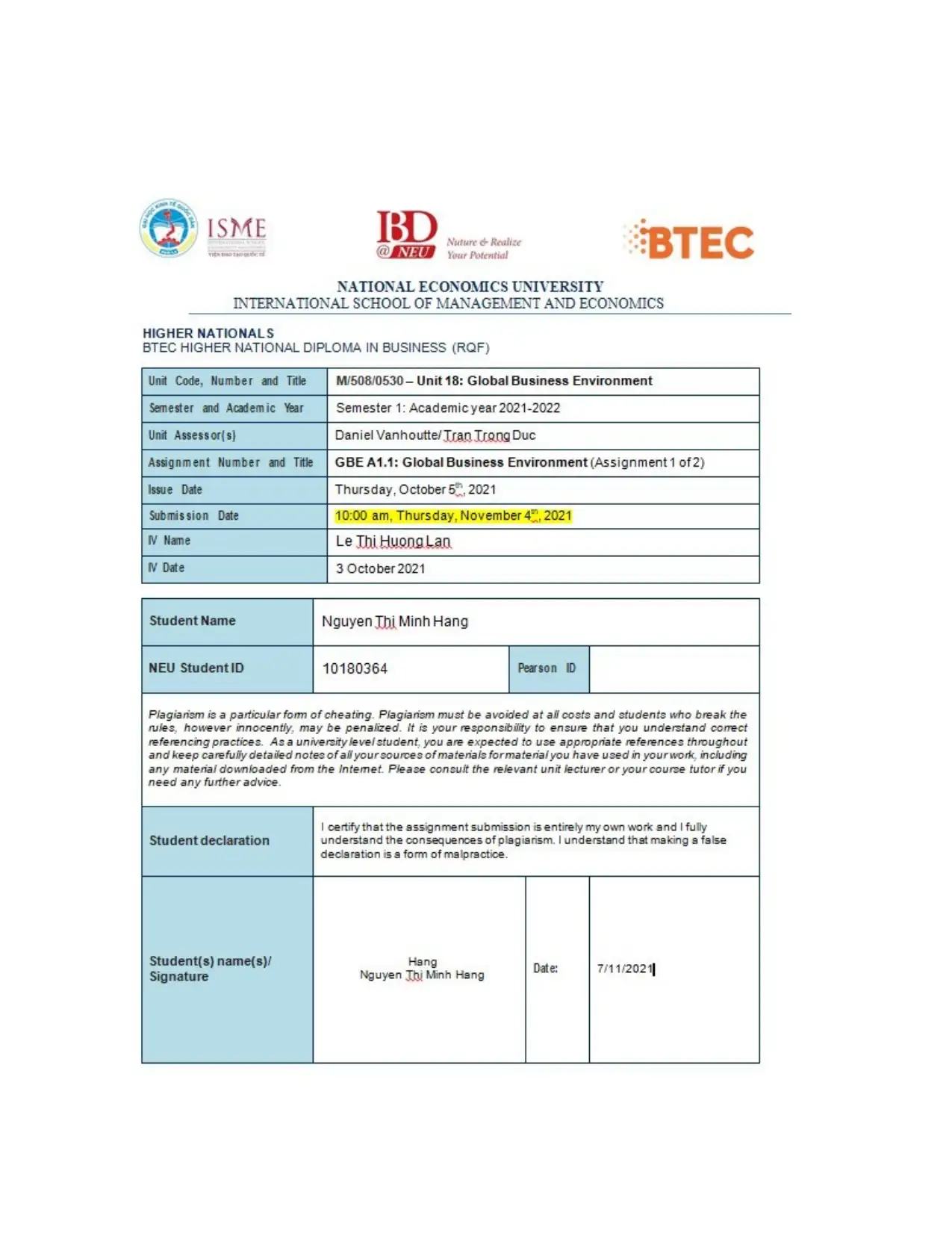
Paraphrase This Document
Need a fresh take? Get an instant paraphrase of this document with our AI Paraphraser
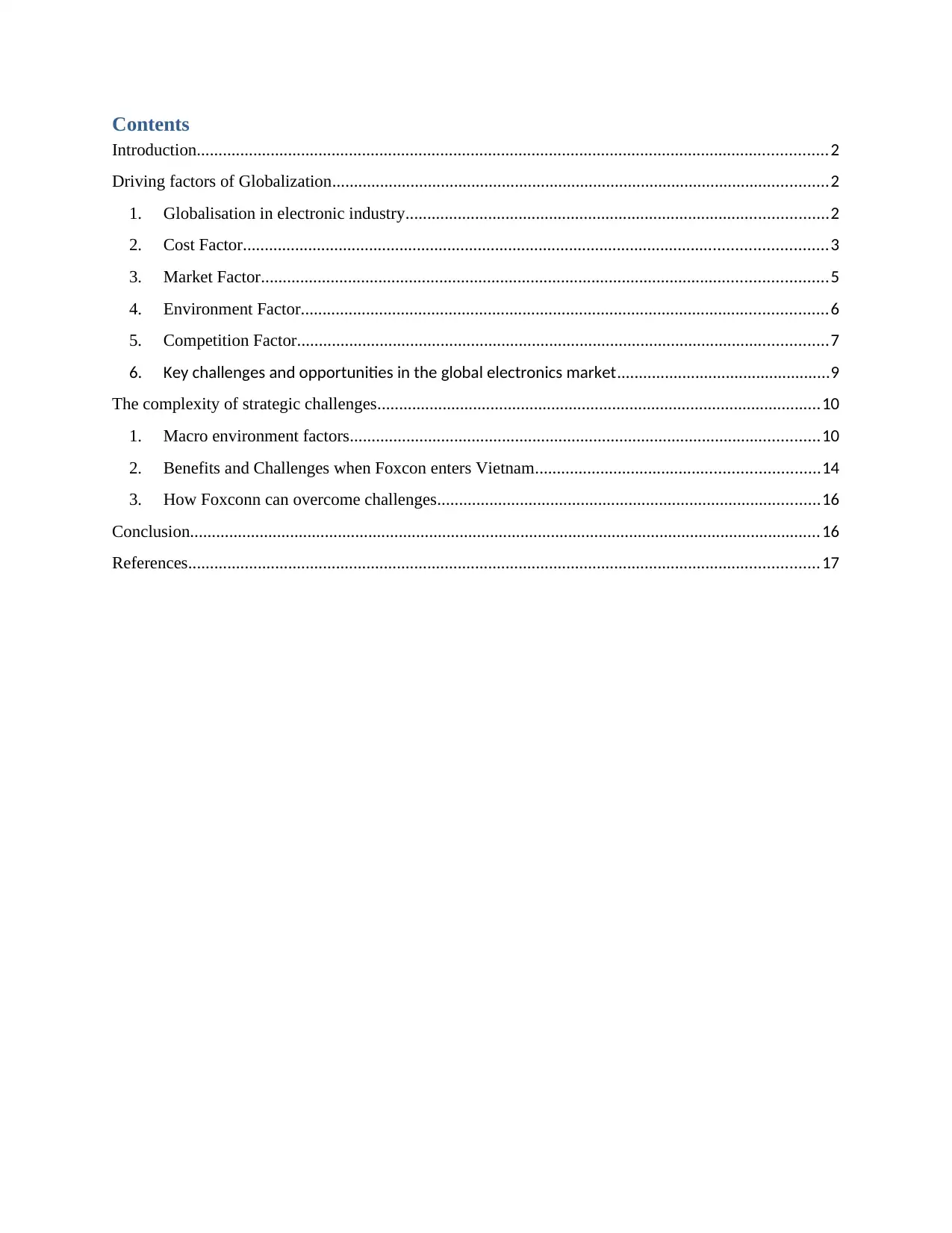
Contents
Introduction.................................................................................................................................................2
Driving factors of Globalization..................................................................................................................2
1. Globalisation in electronic industry.................................................................................................2
2. Cost Factor......................................................................................................................................3
3. Market Factor..................................................................................................................................5
4. Environment Factor.........................................................................................................................6
5. Competition Factor..........................................................................................................................7
6. Key challenges and opportunities in the global electronics market.................................................9
The complexity of strategic challenges......................................................................................................10
1. Macro environment factors............................................................................................................10
2. Benefits and Challenges when Foxcon enters Vietnam.................................................................14
3. How Foxconn can overcome challenges........................................................................................16
Conclusion.................................................................................................................................................16
References.................................................................................................................................................17
Introduction.................................................................................................................................................2
Driving factors of Globalization..................................................................................................................2
1. Globalisation in electronic industry.................................................................................................2
2. Cost Factor......................................................................................................................................3
3. Market Factor..................................................................................................................................5
4. Environment Factor.........................................................................................................................6
5. Competition Factor..........................................................................................................................7
6. Key challenges and opportunities in the global electronics market.................................................9
The complexity of strategic challenges......................................................................................................10
1. Macro environment factors............................................................................................................10
2. Benefits and Challenges when Foxcon enters Vietnam.................................................................14
3. How Foxconn can overcome challenges........................................................................................16
Conclusion.................................................................................................................................................16
References.................................................................................................................................................17
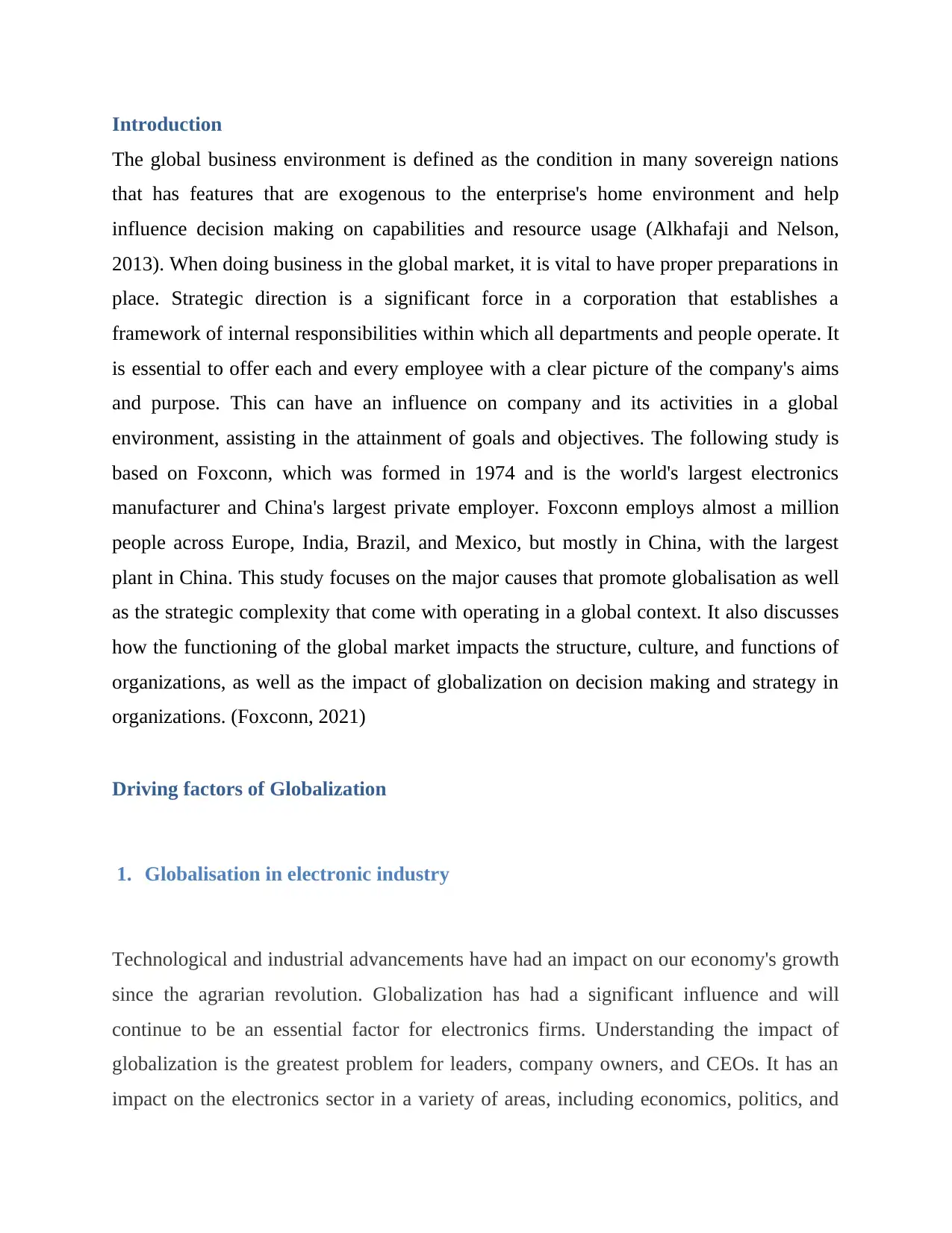
Introduction
The global business environment is defined as the condition in many sovereign nations
that has features that are exogenous to the enterprise's home environment and help
influence decision making on capabilities and resource usage (Alkhafaji and Nelson,
2013). When doing business in the global market, it is vital to have proper preparations in
place. Strategic direction is a significant force in a corporation that establishes a
framework of internal responsibilities within which all departments and people operate. It
is essential to offer each and every employee with a clear picture of the company's aims
and purpose. This can have an influence on company and its activities in a global
environment, assisting in the attainment of goals and objectives. The following study is
based on Foxconn, which was formed in 1974 and is the world's largest electronics
manufacturer and China's largest private employer. Foxconn employs almost a million
people across Europe, India, Brazil, and Mexico, but mostly in China, with the largest
plant in China. This study focuses on the major causes that promote globalisation as well
as the strategic complexity that come with operating in a global context. It also discusses
how the functioning of the global market impacts the structure, culture, and functions of
organizations, as well as the impact of globalization on decision making and strategy in
organizations. (Foxconn, 2021)
Driving factors of Globalization
1. Globalisation in electronic industry
Technological and industrial advancements have had an impact on our economy's growth
since the agrarian revolution. Globalization has had a significant influence and will
continue to be an essential factor for electronics firms. Understanding the impact of
globalization is the greatest problem for leaders, company owners, and CEOs. It has an
impact on the electronics sector in a variety of areas, including economics, politics, and
The global business environment is defined as the condition in many sovereign nations
that has features that are exogenous to the enterprise's home environment and help
influence decision making on capabilities and resource usage (Alkhafaji and Nelson,
2013). When doing business in the global market, it is vital to have proper preparations in
place. Strategic direction is a significant force in a corporation that establishes a
framework of internal responsibilities within which all departments and people operate. It
is essential to offer each and every employee with a clear picture of the company's aims
and purpose. This can have an influence on company and its activities in a global
environment, assisting in the attainment of goals and objectives. The following study is
based on Foxconn, which was formed in 1974 and is the world's largest electronics
manufacturer and China's largest private employer. Foxconn employs almost a million
people across Europe, India, Brazil, and Mexico, but mostly in China, with the largest
plant in China. This study focuses on the major causes that promote globalisation as well
as the strategic complexity that come with operating in a global context. It also discusses
how the functioning of the global market impacts the structure, culture, and functions of
organizations, as well as the impact of globalization on decision making and strategy in
organizations. (Foxconn, 2021)
Driving factors of Globalization
1. Globalisation in electronic industry
Technological and industrial advancements have had an impact on our economy's growth
since the agrarian revolution. Globalization has had a significant influence and will
continue to be an essential factor for electronics firms. Understanding the impact of
globalization is the greatest problem for leaders, company owners, and CEOs. It has an
impact on the electronics sector in a variety of areas, including economics, politics, and
⊘ This is a preview!⊘
Do you want full access?
Subscribe today to unlock all pages.

Trusted by 1+ million students worldwide
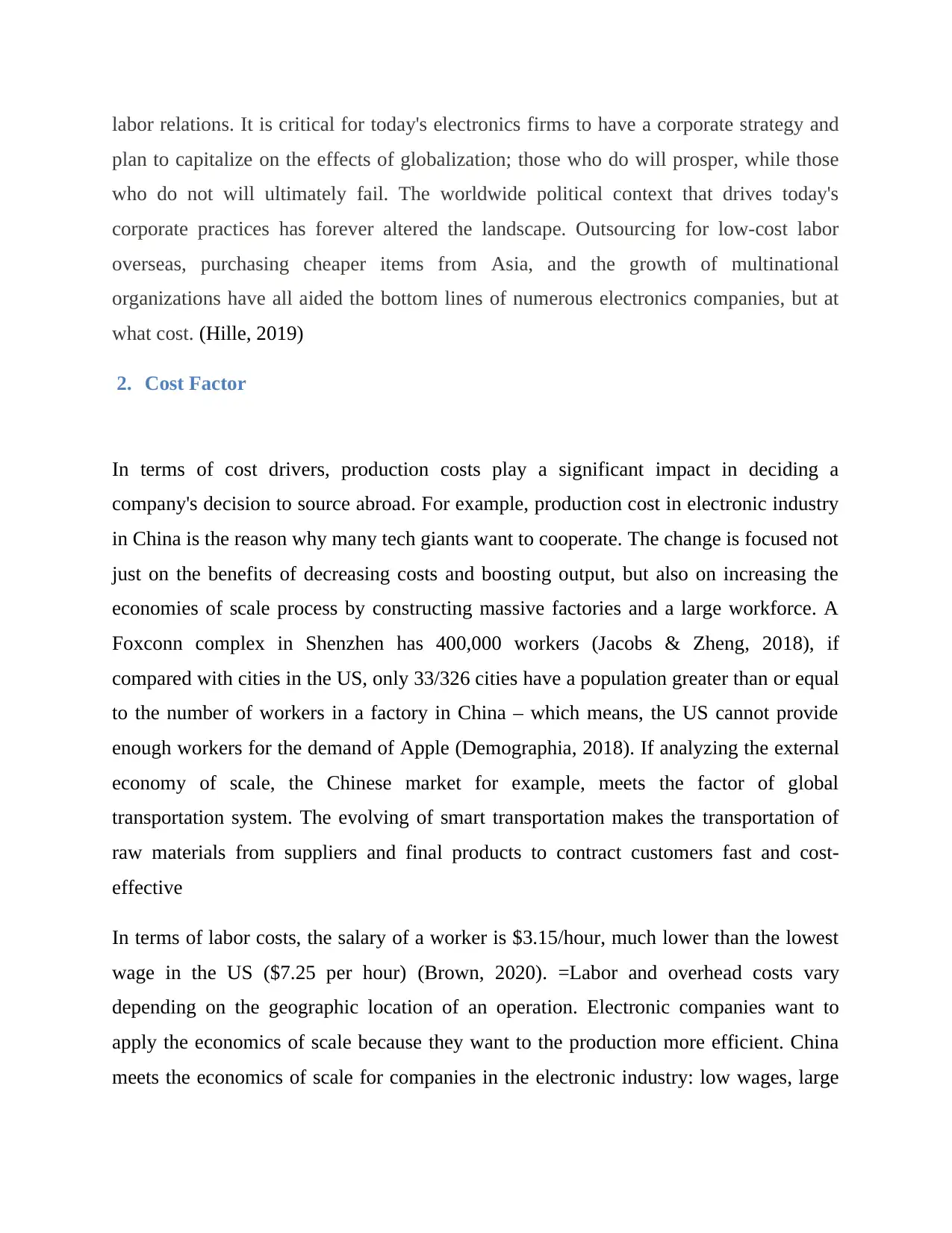
labor relations. It is critical for today's electronics firms to have a corporate strategy and
plan to capitalize on the effects of globalization; those who do will prosper, while those
who do not will ultimately fail. The worldwide political context that drives today's
corporate practices has forever altered the landscape. Outsourcing for low-cost labor
overseas, purchasing cheaper items from Asia, and the growth of multinational
organizations have all aided the bottom lines of numerous electronics companies, but at
what cost. (Hille, 2019)
2. Cost Factor
In terms of cost drivers, production costs play a significant impact in deciding a
company's decision to source abroad. For example, production cost in electronic industry
in China is the reason why many tech giants want to cooperate. The change is focused not
just on the benefits of decreasing costs and boosting output, but also on increasing the
economies of scale process by constructing massive factories and a large workforce. A
Foxconn complex in Shenzhen has 400,000 workers (Jacobs & Zheng, 2018), if
compared with cities in the US, only 33/326 cities have a population greater than or equal
to the number of workers in a factory in China – which means, the US cannot provide
enough workers for the demand of Apple (Demographia, 2018). If analyzing the external
economy of scale, the Chinese market for example, meets the factor of global
transportation system. The evolving of smart transportation makes the transportation of
raw materials from suppliers and final products to contract customers fast and cost-
effective
In terms of labor costs, the salary of a worker is $3.15/hour, much lower than the lowest
wage in the US ($7.25 per hour) (Brown, 2020). =Labor and overhead costs vary
depending on the geographic location of an operation. Electronic companies want to
apply the economics of scale because they want to the production more efficient. China
meets the economics of scale for companies in the electronic industry: low wages, large
plan to capitalize on the effects of globalization; those who do will prosper, while those
who do not will ultimately fail. The worldwide political context that drives today's
corporate practices has forever altered the landscape. Outsourcing for low-cost labor
overseas, purchasing cheaper items from Asia, and the growth of multinational
organizations have all aided the bottom lines of numerous electronics companies, but at
what cost. (Hille, 2019)
2. Cost Factor
In terms of cost drivers, production costs play a significant impact in deciding a
company's decision to source abroad. For example, production cost in electronic industry
in China is the reason why many tech giants want to cooperate. The change is focused not
just on the benefits of decreasing costs and boosting output, but also on increasing the
economies of scale process by constructing massive factories and a large workforce. A
Foxconn complex in Shenzhen has 400,000 workers (Jacobs & Zheng, 2018), if
compared with cities in the US, only 33/326 cities have a population greater than or equal
to the number of workers in a factory in China – which means, the US cannot provide
enough workers for the demand of Apple (Demographia, 2018). If analyzing the external
economy of scale, the Chinese market for example, meets the factor of global
transportation system. The evolving of smart transportation makes the transportation of
raw materials from suppliers and final products to contract customers fast and cost-
effective
In terms of labor costs, the salary of a worker is $3.15/hour, much lower than the lowest
wage in the US ($7.25 per hour) (Brown, 2020). =Labor and overhead costs vary
depending on the geographic location of an operation. Electronic companies want to
apply the economics of scale because they want to the production more efficient. China
meets the economics of scale for companies in the electronic industry: low wages, large
Paraphrase This Document
Need a fresh take? Get an instant paraphrase of this document with our AI Paraphraser
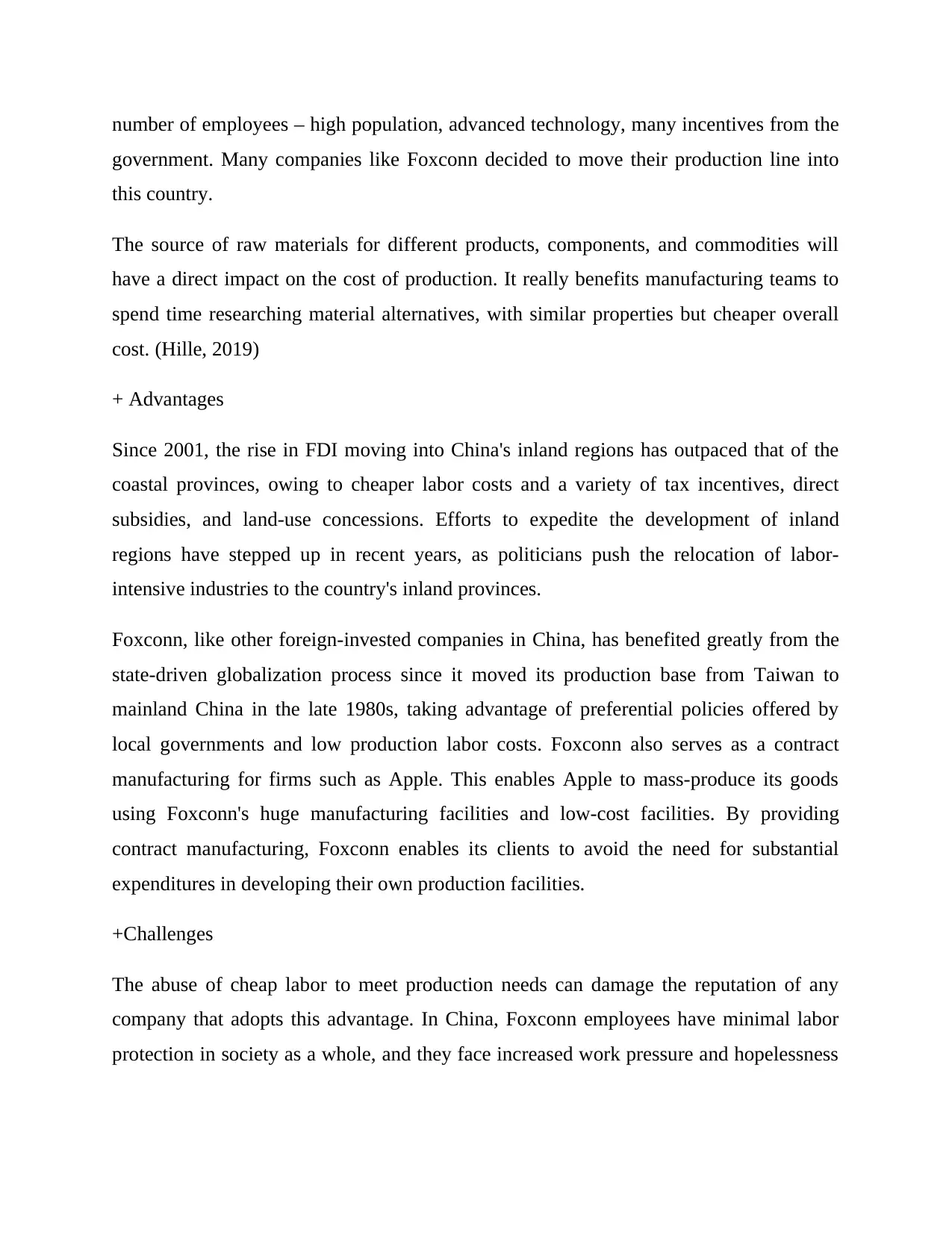
number of employees – high population, advanced technology, many incentives from the
government. Many companies like Foxconn decided to move their production line into
this country.
The source of raw materials for different products, components, and commodities will
have a direct impact on the cost of production. It really benefits manufacturing teams to
spend time researching material alternatives, with similar properties but cheaper overall
cost. (Hille, 2019)
+ Advantages
Since 2001, the rise in FDI moving into China's inland regions has outpaced that of the
coastal provinces, owing to cheaper labor costs and a variety of tax incentives, direct
subsidies, and land-use concessions. Efforts to expedite the development of inland
regions have stepped up in recent years, as politicians push the relocation of labor-
intensive industries to the country's inland provinces.
Foxconn, like other foreign-invested companies in China, has benefited greatly from the
state-driven globalization process since it moved its production base from Taiwan to
mainland China in the late 1980s, taking advantage of preferential policies offered by
local governments and low production labor costs. Foxconn also serves as a contract
manufacturing for firms such as Apple. This enables Apple to mass-produce its goods
using Foxconn's huge manufacturing facilities and low-cost facilities. By providing
contract manufacturing, Foxconn enables its clients to avoid the need for substantial
expenditures in developing their own production facilities.
+Challenges
The abuse of cheap labor to meet production needs can damage the reputation of any
company that adopts this advantage. In China, Foxconn employees have minimal labor
protection in society as a whole, and they face increased work pressure and hopelessness
government. Many companies like Foxconn decided to move their production line into
this country.
The source of raw materials for different products, components, and commodities will
have a direct impact on the cost of production. It really benefits manufacturing teams to
spend time researching material alternatives, with similar properties but cheaper overall
cost. (Hille, 2019)
+ Advantages
Since 2001, the rise in FDI moving into China's inland regions has outpaced that of the
coastal provinces, owing to cheaper labor costs and a variety of tax incentives, direct
subsidies, and land-use concessions. Efforts to expedite the development of inland
regions have stepped up in recent years, as politicians push the relocation of labor-
intensive industries to the country's inland provinces.
Foxconn, like other foreign-invested companies in China, has benefited greatly from the
state-driven globalization process since it moved its production base from Taiwan to
mainland China in the late 1980s, taking advantage of preferential policies offered by
local governments and low production labor costs. Foxconn also serves as a contract
manufacturing for firms such as Apple. This enables Apple to mass-produce its goods
using Foxconn's huge manufacturing facilities and low-cost facilities. By providing
contract manufacturing, Foxconn enables its clients to avoid the need for substantial
expenditures in developing their own production facilities.
+Challenges
The abuse of cheap labor to meet production needs can damage the reputation of any
company that adopts this advantage. In China, Foxconn employees have minimal labor
protection in society as a whole, and they face increased work pressure and hopelessness
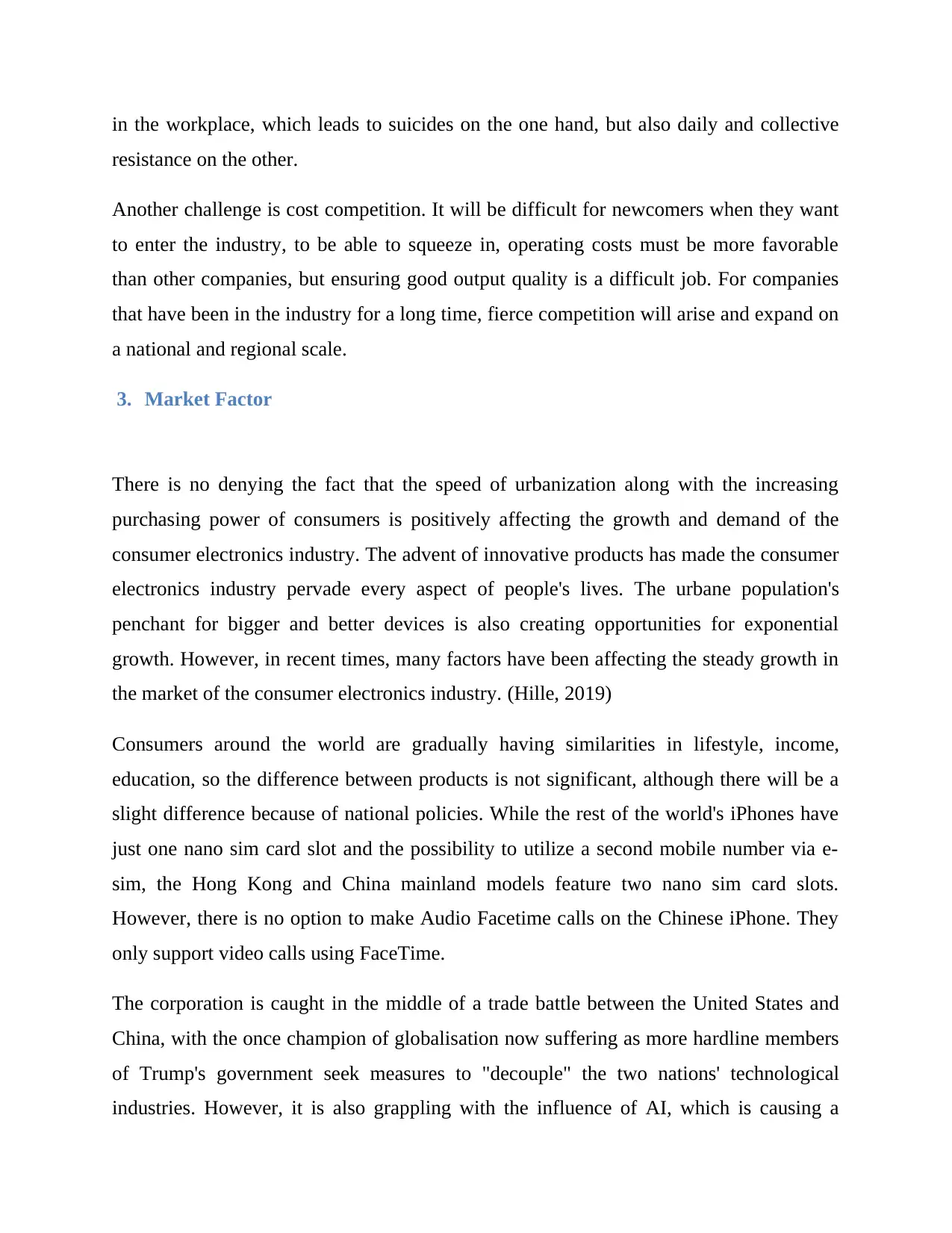
in the workplace, which leads to suicides on the one hand, but also daily and collective
resistance on the other.
Another challenge is cost competition. It will be difficult for newcomers when they want
to enter the industry, to be able to squeeze in, operating costs must be more favorable
than other companies, but ensuring good output quality is a difficult job. For companies
that have been in the industry for a long time, fierce competition will arise and expand on
a national and regional scale.
3. Market Factor
There is no denying the fact that the speed of urbanization along with the increasing
purchasing power of consumers is positively affecting the growth and demand of the
consumer electronics industry. The advent of innovative products has made the consumer
electronics industry pervade every aspect of people's lives. The urbane population's
penchant for bigger and better devices is also creating opportunities for exponential
growth. However, in recent times, many factors have been affecting the steady growth in
the market of the consumer electronics industry. (Hille, 2019)
Consumers around the world are gradually having similarities in lifestyle, income,
education, so the difference between products is not significant, although there will be a
slight difference because of national policies. While the rest of the world's iPhones have
just one nano sim card slot and the possibility to utilize a second mobile number via e-
sim, the Hong Kong and China mainland models feature two nano sim card slots.
However, there is no option to make Audio Facetime calls on the Chinese iPhone. They
only support video calls using FaceTime.
The corporation is caught in the middle of a trade battle between the United States and
China, with the once champion of globalisation now suffering as more hardline members
of Trump's government seek measures to "decouple" the two nations' technological
industries. However, it is also grappling with the influence of AI, which is causing a
resistance on the other.
Another challenge is cost competition. It will be difficult for newcomers when they want
to enter the industry, to be able to squeeze in, operating costs must be more favorable
than other companies, but ensuring good output quality is a difficult job. For companies
that have been in the industry for a long time, fierce competition will arise and expand on
a national and regional scale.
3. Market Factor
There is no denying the fact that the speed of urbanization along with the increasing
purchasing power of consumers is positively affecting the growth and demand of the
consumer electronics industry. The advent of innovative products has made the consumer
electronics industry pervade every aspect of people's lives. The urbane population's
penchant for bigger and better devices is also creating opportunities for exponential
growth. However, in recent times, many factors have been affecting the steady growth in
the market of the consumer electronics industry. (Hille, 2019)
Consumers around the world are gradually having similarities in lifestyle, income,
education, so the difference between products is not significant, although there will be a
slight difference because of national policies. While the rest of the world's iPhones have
just one nano sim card slot and the possibility to utilize a second mobile number via e-
sim, the Hong Kong and China mainland models feature two nano sim card slots.
However, there is no option to make Audio Facetime calls on the Chinese iPhone. They
only support video calls using FaceTime.
The corporation is caught in the middle of a trade battle between the United States and
China, with the once champion of globalisation now suffering as more hardline members
of Trump's government seek measures to "decouple" the two nations' technological
industries. However, it is also grappling with the influence of AI, which is causing a
⊘ This is a preview!⊘
Do you want full access?
Subscribe today to unlock all pages.

Trusted by 1+ million students worldwide
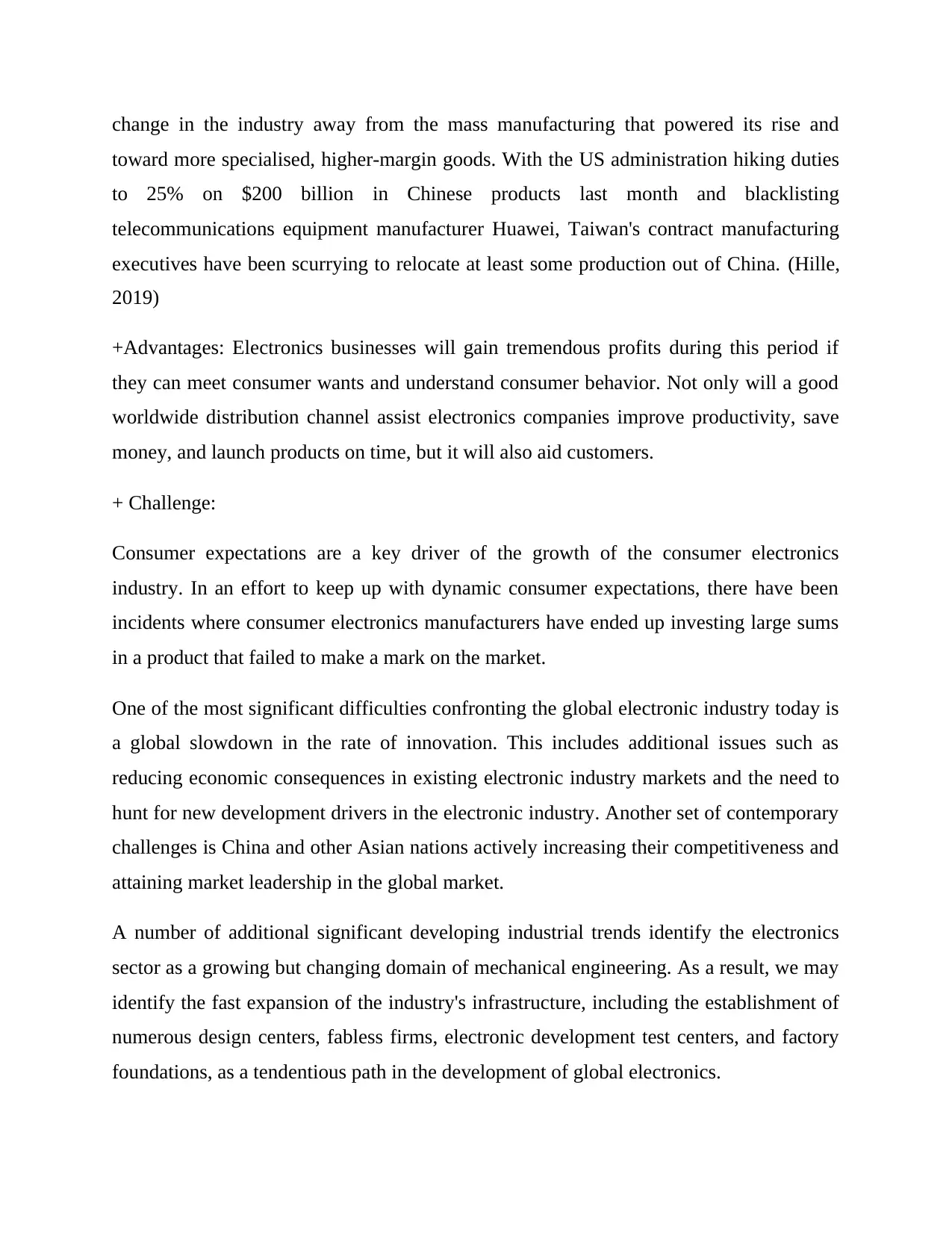
change in the industry away from the mass manufacturing that powered its rise and
toward more specialised, higher-margin goods. With the US administration hiking duties
to 25% on $200 billion in Chinese products last month and blacklisting
telecommunications equipment manufacturer Huawei, Taiwan's contract manufacturing
executives have been scurrying to relocate at least some production out of China. (Hille,
2019)
+Advantages: Electronics businesses will gain tremendous profits during this period if
they can meet consumer wants and understand consumer behavior. Not only will a good
worldwide distribution channel assist electronics companies improve productivity, save
money, and launch products on time, but it will also aid customers.
+ Challenge:
Consumer expectations are a key driver of the growth of the consumer electronics
industry. In an effort to keep up with dynamic consumer expectations, there have been
incidents where consumer electronics manufacturers have ended up investing large sums
in a product that failed to make a mark on the market.
One of the most significant difficulties confronting the global electronic industry today is
a global slowdown in the rate of innovation. This includes additional issues such as
reducing economic consequences in existing electronic industry markets and the need to
hunt for new development drivers in the electronic industry. Another set of contemporary
challenges is China and other Asian nations actively increasing their competitiveness and
attaining market leadership in the global market.
A number of additional significant developing industrial trends identify the electronics
sector as a growing but changing domain of mechanical engineering. As a result, we may
identify the fast expansion of the industry's infrastructure, including the establishment of
numerous design centers, fabless firms, electronic development test centers, and factory
foundations, as a tendentious path in the development of global electronics.
toward more specialised, higher-margin goods. With the US administration hiking duties
to 25% on $200 billion in Chinese products last month and blacklisting
telecommunications equipment manufacturer Huawei, Taiwan's contract manufacturing
executives have been scurrying to relocate at least some production out of China. (Hille,
2019)
+Advantages: Electronics businesses will gain tremendous profits during this period if
they can meet consumer wants and understand consumer behavior. Not only will a good
worldwide distribution channel assist electronics companies improve productivity, save
money, and launch products on time, but it will also aid customers.
+ Challenge:
Consumer expectations are a key driver of the growth of the consumer electronics
industry. In an effort to keep up with dynamic consumer expectations, there have been
incidents where consumer electronics manufacturers have ended up investing large sums
in a product that failed to make a mark on the market.
One of the most significant difficulties confronting the global electronic industry today is
a global slowdown in the rate of innovation. This includes additional issues such as
reducing economic consequences in existing electronic industry markets and the need to
hunt for new development drivers in the electronic industry. Another set of contemporary
challenges is China and other Asian nations actively increasing their competitiveness and
attaining market leadership in the global market.
A number of additional significant developing industrial trends identify the electronics
sector as a growing but changing domain of mechanical engineering. As a result, we may
identify the fast expansion of the industry's infrastructure, including the establishment of
numerous design centers, fabless firms, electronic development test centers, and factory
foundations, as a tendentious path in the development of global electronics.
Paraphrase This Document
Need a fresh take? Get an instant paraphrase of this document with our AI Paraphraser
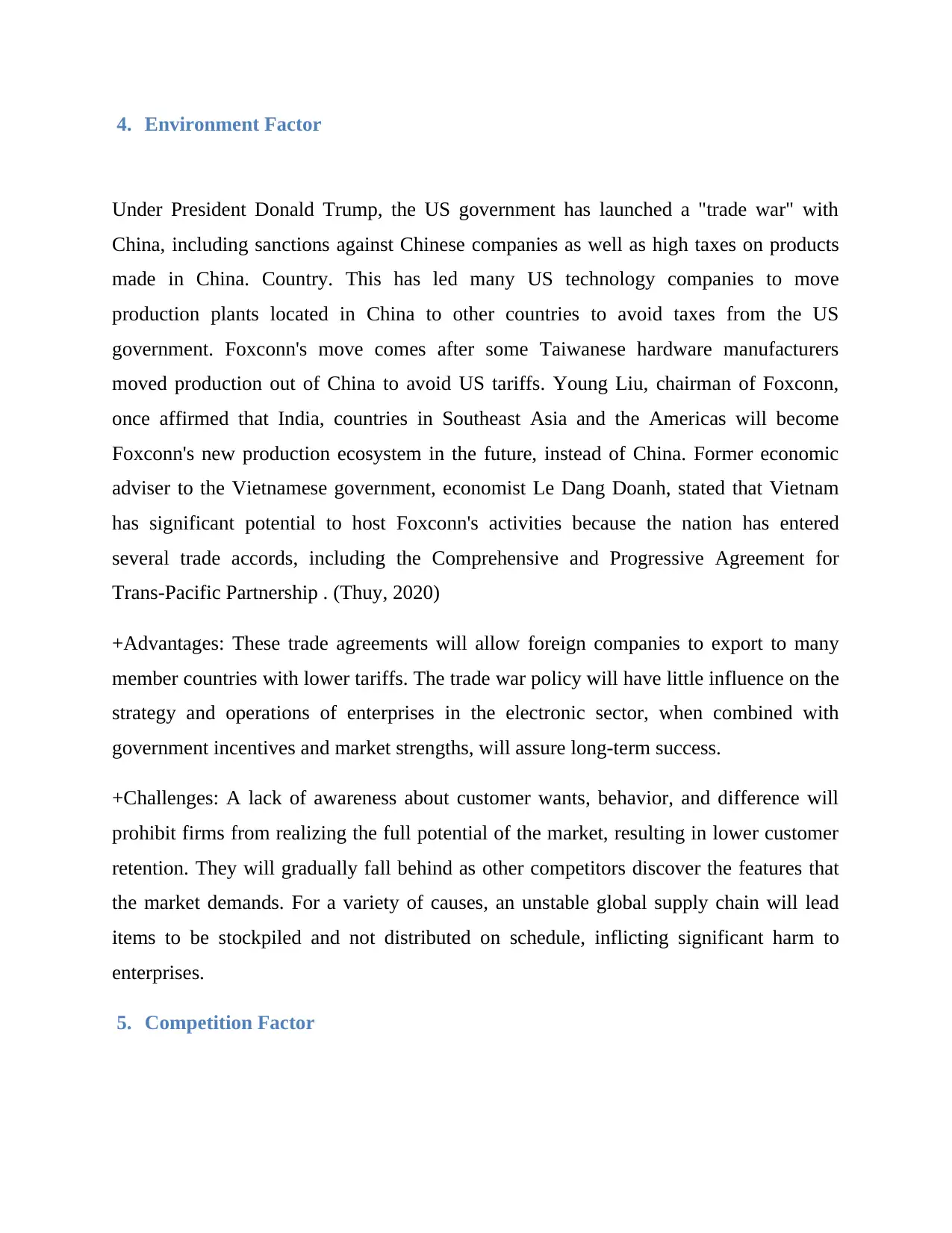
4. Environment Factor
Under President Donald Trump, the US government has launched a "trade war" with
China, including sanctions against Chinese companies as well as high taxes on products
made in China. Country. This has led many US technology companies to move
production plants located in China to other countries to avoid taxes from the US
government. Foxconn's move comes after some Taiwanese hardware manufacturers
moved production out of China to avoid US tariffs. Young Liu, chairman of Foxconn,
once affirmed that India, countries in Southeast Asia and the Americas will become
Foxconn's new production ecosystem in the future, instead of China. Former economic
adviser to the Vietnamese government, economist Le Dang Doanh, stated that Vietnam
has significant potential to host Foxconn's activities because the nation has entered
several trade accords, including the Comprehensive and Progressive Agreement for
Trans-Pacific Partnership . (Thuy, 2020)
+Advantages: These trade agreements will allow foreign companies to export to many
member countries with lower tariffs. The trade war policy will have little influence on the
strategy and operations of enterprises in the electronic sector, when combined with
government incentives and market strengths, will assure long-term success.
+Challenges: A lack of awareness about customer wants, behavior, and difference will
prohibit firms from realizing the full potential of the market, resulting in lower customer
retention. They will gradually fall behind as other competitors discover the features that
the market demands. For a variety of causes, an unstable global supply chain will lead
items to be stockpiled and not distributed on schedule, inflicting significant harm to
enterprises.
5. Competition Factor
Under President Donald Trump, the US government has launched a "trade war" with
China, including sanctions against Chinese companies as well as high taxes on products
made in China. Country. This has led many US technology companies to move
production plants located in China to other countries to avoid taxes from the US
government. Foxconn's move comes after some Taiwanese hardware manufacturers
moved production out of China to avoid US tariffs. Young Liu, chairman of Foxconn,
once affirmed that India, countries in Southeast Asia and the Americas will become
Foxconn's new production ecosystem in the future, instead of China. Former economic
adviser to the Vietnamese government, economist Le Dang Doanh, stated that Vietnam
has significant potential to host Foxconn's activities because the nation has entered
several trade accords, including the Comprehensive and Progressive Agreement for
Trans-Pacific Partnership . (Thuy, 2020)
+Advantages: These trade agreements will allow foreign companies to export to many
member countries with lower tariffs. The trade war policy will have little influence on the
strategy and operations of enterprises in the electronic sector, when combined with
government incentives and market strengths, will assure long-term success.
+Challenges: A lack of awareness about customer wants, behavior, and difference will
prohibit firms from realizing the full potential of the market, resulting in lower customer
retention. They will gradually fall behind as other competitors discover the features that
the market demands. For a variety of causes, an unstable global supply chain will lead
items to be stockpiled and not distributed on schedule, inflicting significant harm to
enterprises.
5. Competition Factor
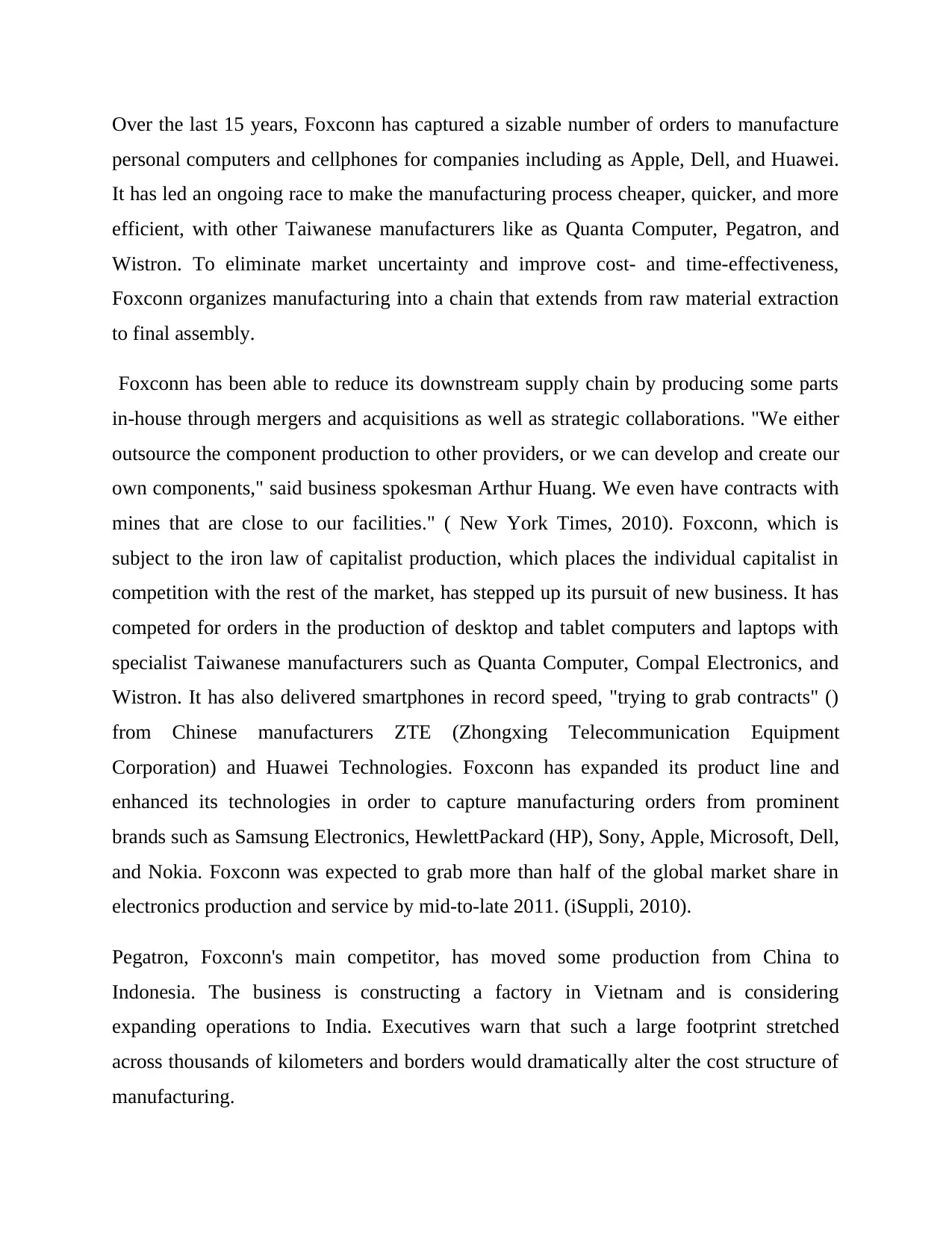
Over the last 15 years, Foxconn has captured a sizable number of orders to manufacture
personal computers and cellphones for companies including as Apple, Dell, and Huawei.
It has led an ongoing race to make the manufacturing process cheaper, quicker, and more
efficient, with other Taiwanese manufacturers like as Quanta Computer, Pegatron, and
Wistron. To eliminate market uncertainty and improve cost- and time-effectiveness,
Foxconn organizes manufacturing into a chain that extends from raw material extraction
to final assembly.
Foxconn has been able to reduce its downstream supply chain by producing some parts
in-house through mergers and acquisitions as well as strategic collaborations. "We either
outsource the component production to other providers, or we can develop and create our
own components," said business spokesman Arthur Huang. We even have contracts with
mines that are close to our facilities." ( New York Times, 2010). Foxconn, which is
subject to the iron law of capitalist production, which places the individual capitalist in
competition with the rest of the market, has stepped up its pursuit of new business. It has
competed for orders in the production of desktop and tablet computers and laptops with
specialist Taiwanese manufacturers such as Quanta Computer, Compal Electronics, and
Wistron. It has also delivered smartphones in record speed, "trying to grab contracts" ()
from Chinese manufacturers ZTE (Zhongxing Telecommunication Equipment
Corporation) and Huawei Technologies. Foxconn has expanded its product line and
enhanced its technologies in order to capture manufacturing orders from prominent
brands such as Samsung Electronics, HewlettPackard (HP), Sony, Apple, Microsoft, Dell,
and Nokia. Foxconn was expected to grab more than half of the global market share in
electronics production and service by mid-to-late 2011. (iSuppli, 2010).
Pegatron, Foxconn's main competitor, has moved some production from China to
Indonesia. The business is constructing a factory in Vietnam and is considering
expanding operations to India. Executives warn that such a large footprint stretched
across thousands of kilometers and borders would dramatically alter the cost structure of
manufacturing.
personal computers and cellphones for companies including as Apple, Dell, and Huawei.
It has led an ongoing race to make the manufacturing process cheaper, quicker, and more
efficient, with other Taiwanese manufacturers like as Quanta Computer, Pegatron, and
Wistron. To eliminate market uncertainty and improve cost- and time-effectiveness,
Foxconn organizes manufacturing into a chain that extends from raw material extraction
to final assembly.
Foxconn has been able to reduce its downstream supply chain by producing some parts
in-house through mergers and acquisitions as well as strategic collaborations. "We either
outsource the component production to other providers, or we can develop and create our
own components," said business spokesman Arthur Huang. We even have contracts with
mines that are close to our facilities." ( New York Times, 2010). Foxconn, which is
subject to the iron law of capitalist production, which places the individual capitalist in
competition with the rest of the market, has stepped up its pursuit of new business. It has
competed for orders in the production of desktop and tablet computers and laptops with
specialist Taiwanese manufacturers such as Quanta Computer, Compal Electronics, and
Wistron. It has also delivered smartphones in record speed, "trying to grab contracts" ()
from Chinese manufacturers ZTE (Zhongxing Telecommunication Equipment
Corporation) and Huawei Technologies. Foxconn has expanded its product line and
enhanced its technologies in order to capture manufacturing orders from prominent
brands such as Samsung Electronics, HewlettPackard (HP), Sony, Apple, Microsoft, Dell,
and Nokia. Foxconn was expected to grab more than half of the global market share in
electronics production and service by mid-to-late 2011. (iSuppli, 2010).
Pegatron, Foxconn's main competitor, has moved some production from China to
Indonesia. The business is constructing a factory in Vietnam and is considering
expanding operations to India. Executives warn that such a large footprint stretched
across thousands of kilometers and borders would dramatically alter the cost structure of
manufacturing.
⊘ This is a preview!⊘
Do you want full access?
Subscribe today to unlock all pages.

Trusted by 1+ million students worldwide
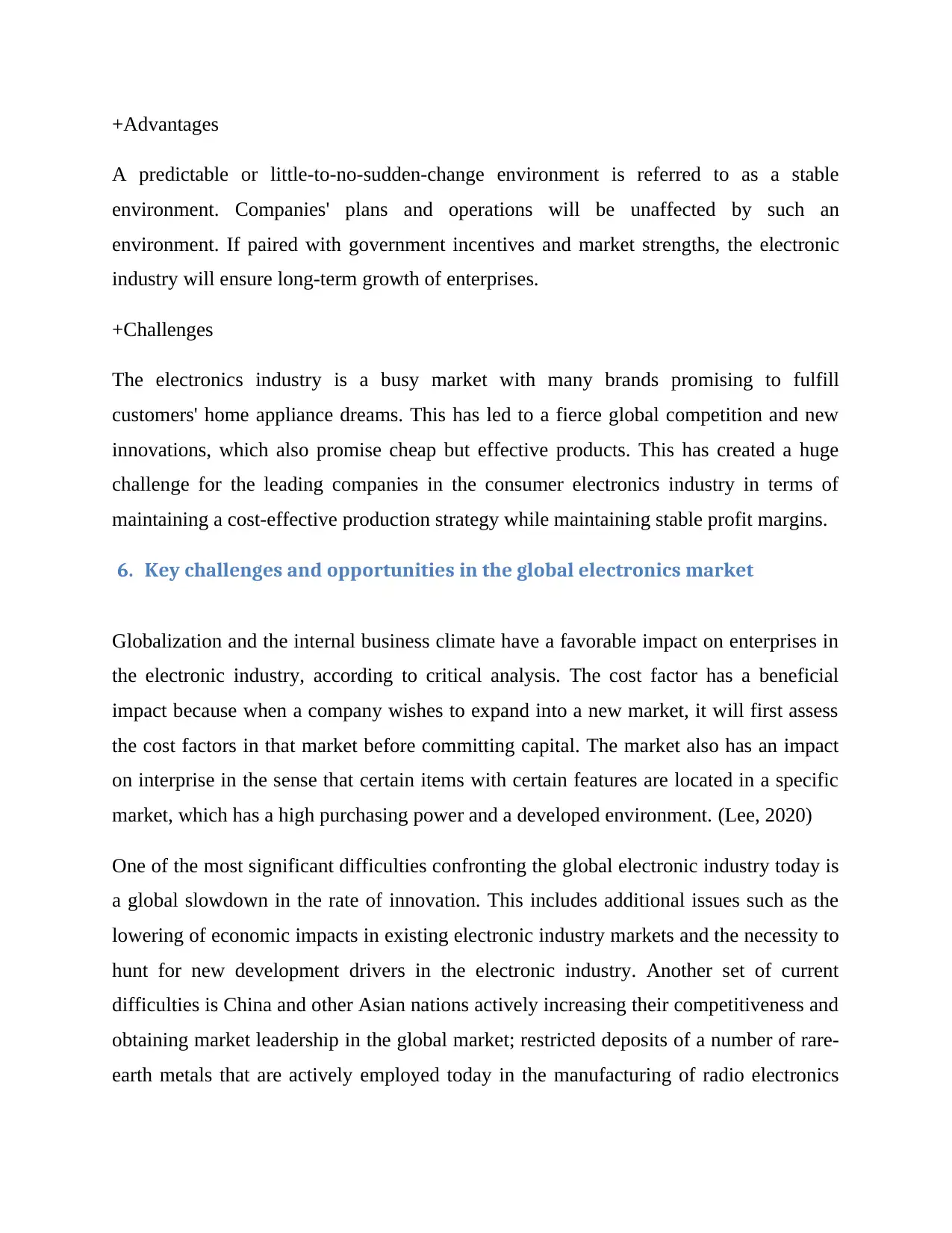
+Advantages
A predictable or little-to-no-sudden-change environment is referred to as a stable
environment. Companies' plans and operations will be unaffected by such an
environment. If paired with government incentives and market strengths, the electronic
industry will ensure long-term growth of enterprises.
+Challenges
The electronics industry is a busy market with many brands promising to fulfill
customers' home appliance dreams. This has led to a fierce global competition and new
innovations, which also promise cheap but effective products. This has created a huge
challenge for the leading companies in the consumer electronics industry in terms of
maintaining a cost-effective production strategy while maintaining stable profit margins.
6. Key challenges and opportunities in the global electronics market
Globalization and the internal business climate have a favorable impact on enterprises in
the electronic industry, according to critical analysis. The cost factor has a beneficial
impact because when a company wishes to expand into a new market, it will first assess
the cost factors in that market before committing capital. The market also has an impact
on interprise in the sense that certain items with certain features are located in a specific
market, which has a high purchasing power and a developed environment. (Lee, 2020)
One of the most significant difficulties confronting the global electronic industry today is
a global slowdown in the rate of innovation. This includes additional issues such as the
lowering of economic impacts in existing electronic industry markets and the necessity to
hunt for new development drivers in the electronic industry. Another set of current
difficulties is China and other Asian nations actively increasing their competitiveness and
obtaining market leadership in the global market; restricted deposits of a number of rare-
earth metals that are actively employed today in the manufacturing of radio electronics
A predictable or little-to-no-sudden-change environment is referred to as a stable
environment. Companies' plans and operations will be unaffected by such an
environment. If paired with government incentives and market strengths, the electronic
industry will ensure long-term growth of enterprises.
+Challenges
The electronics industry is a busy market with many brands promising to fulfill
customers' home appliance dreams. This has led to a fierce global competition and new
innovations, which also promise cheap but effective products. This has created a huge
challenge for the leading companies in the consumer electronics industry in terms of
maintaining a cost-effective production strategy while maintaining stable profit margins.
6. Key challenges and opportunities in the global electronics market
Globalization and the internal business climate have a favorable impact on enterprises in
the electronic industry, according to critical analysis. The cost factor has a beneficial
impact because when a company wishes to expand into a new market, it will first assess
the cost factors in that market before committing capital. The market also has an impact
on interprise in the sense that certain items with certain features are located in a specific
market, which has a high purchasing power and a developed environment. (Lee, 2020)
One of the most significant difficulties confronting the global electronic industry today is
a global slowdown in the rate of innovation. This includes additional issues such as the
lowering of economic impacts in existing electronic industry markets and the necessity to
hunt for new development drivers in the electronic industry. Another set of current
difficulties is China and other Asian nations actively increasing their competitiveness and
obtaining market leadership in the global market; restricted deposits of a number of rare-
earth metals that are actively employed today in the manufacturing of radio electronics
Paraphrase This Document
Need a fresh take? Get an instant paraphrase of this document with our AI Paraphraser
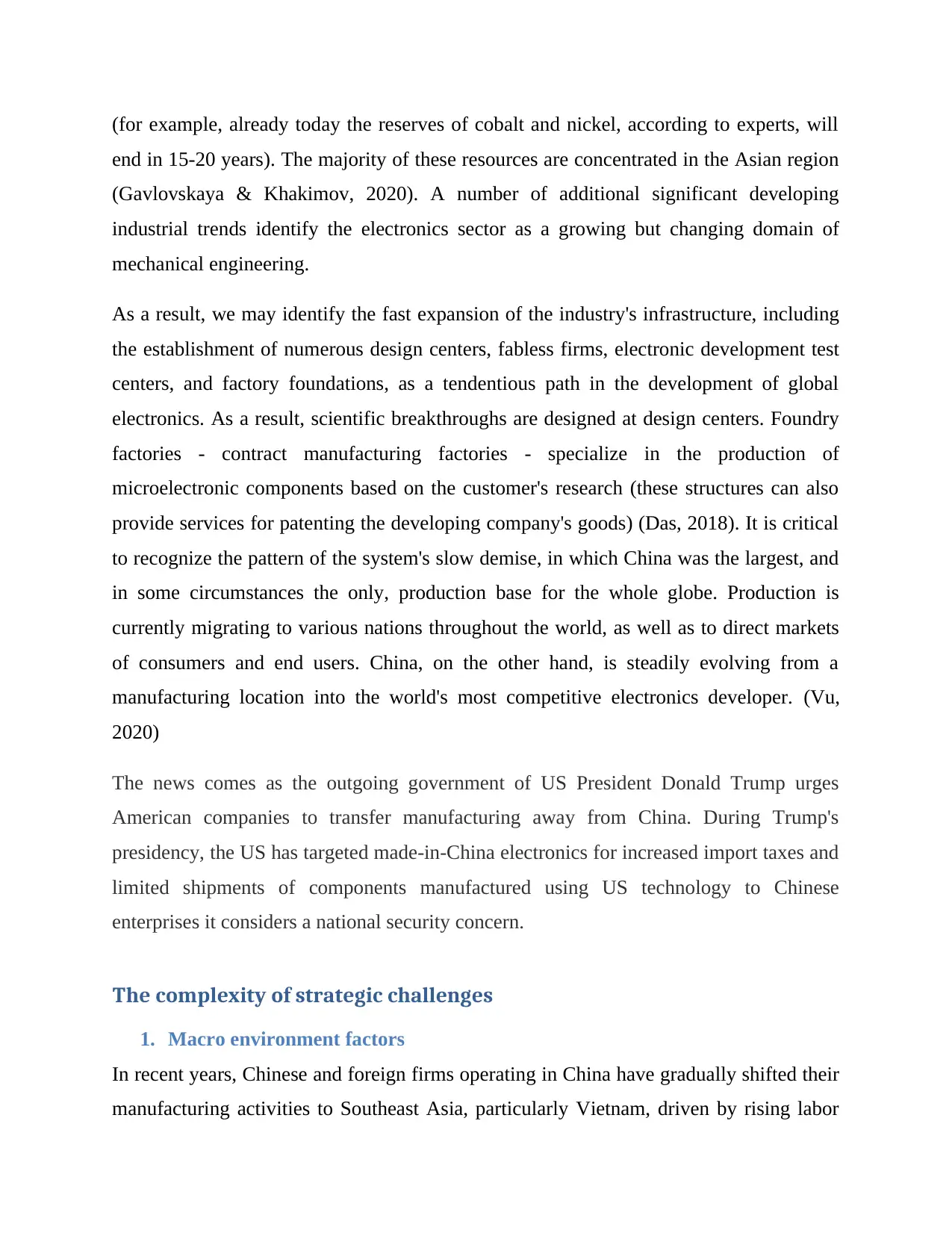
(for example, already today the reserves of cobalt and nickel, according to experts, will
end in 15-20 years). The majority of these resources are concentrated in the Asian region
(Gavlovskaya & Khakimov, 2020). A number of additional significant developing
industrial trends identify the electronics sector as a growing but changing domain of
mechanical engineering.
As a result, we may identify the fast expansion of the industry's infrastructure, including
the establishment of numerous design centers, fabless firms, electronic development test
centers, and factory foundations, as a tendentious path in the development of global
electronics. As a result, scientific breakthroughs are designed at design centers. Foundry
factories - contract manufacturing factories - specialize in the production of
microelectronic components based on the customer's research (these structures can also
provide services for patenting the developing company's goods) (Das, 2018). It is critical
to recognize the pattern of the system's slow demise, in which China was the largest, and
in some circumstances the only, production base for the whole globe. Production is
currently migrating to various nations throughout the world, as well as to direct markets
of consumers and end users. China, on the other hand, is steadily evolving from a
manufacturing location into the world's most competitive electronics developer. (Vu,
2020)
The news comes as the outgoing government of US President Donald Trump urges
American companies to transfer manufacturing away from China. During Trump's
presidency, the US has targeted made-in-China electronics for increased import taxes and
limited shipments of components manufactured using US technology to Chinese
enterprises it considers a national security concern.
The complexity of strategic challenges
1. Macro environment factors
In recent years, Chinese and foreign firms operating in China have gradually shifted their
manufacturing activities to Southeast Asia, particularly Vietnam, driven by rising labor
end in 15-20 years). The majority of these resources are concentrated in the Asian region
(Gavlovskaya & Khakimov, 2020). A number of additional significant developing
industrial trends identify the electronics sector as a growing but changing domain of
mechanical engineering.
As a result, we may identify the fast expansion of the industry's infrastructure, including
the establishment of numerous design centers, fabless firms, electronic development test
centers, and factory foundations, as a tendentious path in the development of global
electronics. As a result, scientific breakthroughs are designed at design centers. Foundry
factories - contract manufacturing factories - specialize in the production of
microelectronic components based on the customer's research (these structures can also
provide services for patenting the developing company's goods) (Das, 2018). It is critical
to recognize the pattern of the system's slow demise, in which China was the largest, and
in some circumstances the only, production base for the whole globe. Production is
currently migrating to various nations throughout the world, as well as to direct markets
of consumers and end users. China, on the other hand, is steadily evolving from a
manufacturing location into the world's most competitive electronics developer. (Vu,
2020)
The news comes as the outgoing government of US President Donald Trump urges
American companies to transfer manufacturing away from China. During Trump's
presidency, the US has targeted made-in-China electronics for increased import taxes and
limited shipments of components manufactured using US technology to Chinese
enterprises it considers a national security concern.
The complexity of strategic challenges
1. Macro environment factors
In recent years, Chinese and foreign firms operating in China have gradually shifted their
manufacturing activities to Southeast Asia, particularly Vietnam, driven by rising labor
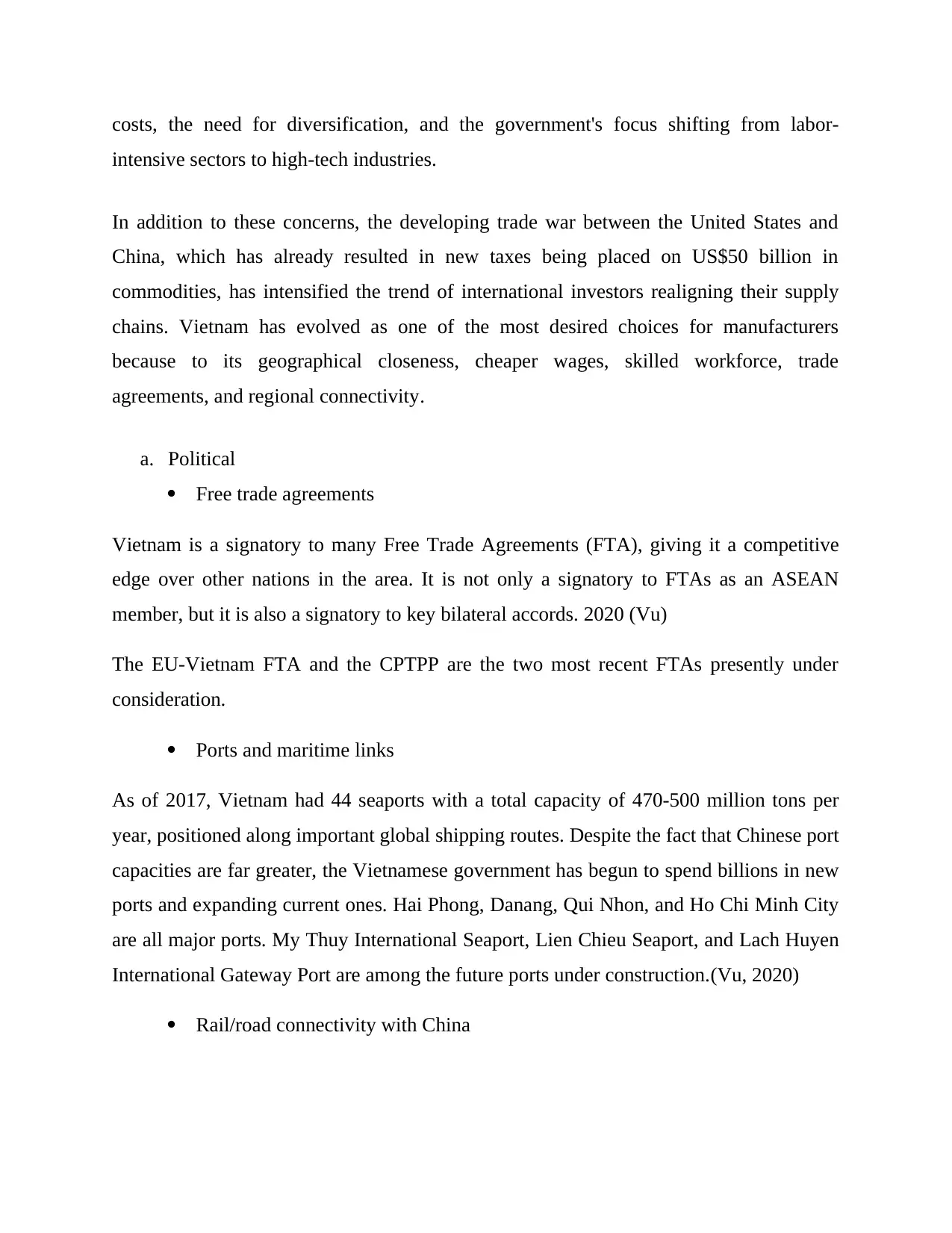
costs, the need for diversification, and the government's focus shifting from labor-
intensive sectors to high-tech industries.
In addition to these concerns, the developing trade war between the United States and
China, which has already resulted in new taxes being placed on US$50 billion in
commodities, has intensified the trend of international investors realigning their supply
chains. Vietnam has evolved as one of the most desired choices for manufacturers
because to its geographical closeness, cheaper wages, skilled workforce, trade
agreements, and regional connectivity.
a. Political
Free trade agreements
Vietnam is a signatory to many Free Trade Agreements (FTA), giving it a competitive
edge over other nations in the area. It is not only a signatory to FTAs as an ASEAN
member, but it is also a signatory to key bilateral accords. 2020 (Vu)
The EU-Vietnam FTA and the CPTPP are the two most recent FTAs presently under
consideration.
Ports and maritime links
As of 2017, Vietnam had 44 seaports with a total capacity of 470-500 million tons per
year, positioned along important global shipping routes. Despite the fact that Chinese port
capacities are far greater, the Vietnamese government has begun to spend billions in new
ports and expanding current ones. Hai Phong, Danang, Qui Nhon, and Ho Chi Minh City
are all major ports. My Thuy International Seaport, Lien Chieu Seaport, and Lach Huyen
International Gateway Port are among the future ports under construction.(Vu, 2020)
Rail/road connectivity with China
intensive sectors to high-tech industries.
In addition to these concerns, the developing trade war between the United States and
China, which has already resulted in new taxes being placed on US$50 billion in
commodities, has intensified the trend of international investors realigning their supply
chains. Vietnam has evolved as one of the most desired choices for manufacturers
because to its geographical closeness, cheaper wages, skilled workforce, trade
agreements, and regional connectivity.
a. Political
Free trade agreements
Vietnam is a signatory to many Free Trade Agreements (FTA), giving it a competitive
edge over other nations in the area. It is not only a signatory to FTAs as an ASEAN
member, but it is also a signatory to key bilateral accords. 2020 (Vu)
The EU-Vietnam FTA and the CPTPP are the two most recent FTAs presently under
consideration.
Ports and maritime links
As of 2017, Vietnam had 44 seaports with a total capacity of 470-500 million tons per
year, positioned along important global shipping routes. Despite the fact that Chinese port
capacities are far greater, the Vietnamese government has begun to spend billions in new
ports and expanding current ones. Hai Phong, Danang, Qui Nhon, and Ho Chi Minh City
are all major ports. My Thuy International Seaport, Lien Chieu Seaport, and Lach Huyen
International Gateway Port are among the future ports under construction.(Vu, 2020)
Rail/road connectivity with China
⊘ This is a preview!⊘
Do you want full access?
Subscribe today to unlock all pages.

Trusted by 1+ million students worldwide
1 out of 20
Related Documents
Your All-in-One AI-Powered Toolkit for Academic Success.
+13062052269
info@desklib.com
Available 24*7 on WhatsApp / Email
![[object Object]](/_next/static/media/star-bottom.7253800d.svg)
Unlock your academic potential
Copyright © 2020–2025 A2Z Services. All Rights Reserved. Developed and managed by ZUCOL.





